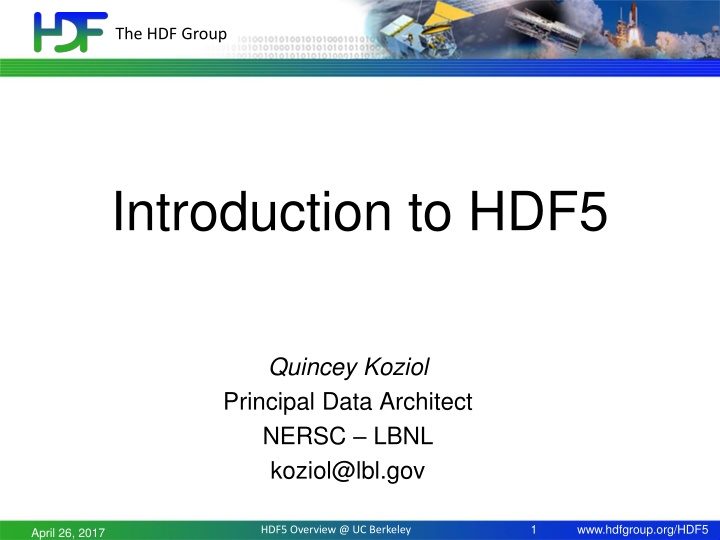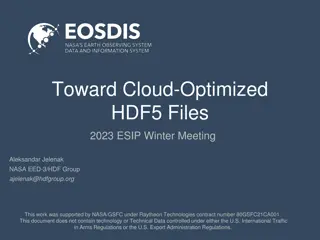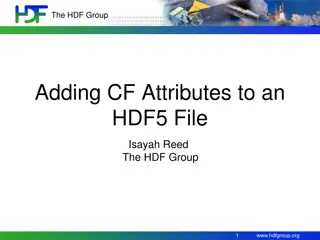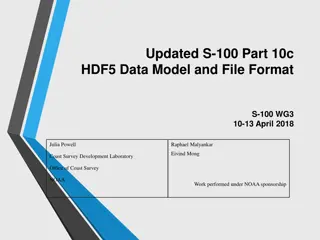Introduction to HDF5
HDF5 is a powerful open file format designed for handling high volume and complex data. It provides an extensible data model with structures for organizing data efficiently. With HDF5, users can focus on their research without dealing with the complexities of file management. Explore the various aspects of HDF5, including its data and programming models, to optimize I/O operations for scientific applications. Learn why HDF5 is suitable for all system types and sizes, offering flexible and efficient storage capabilities while enabling long-term data preservation.
Uploaded on Mar 09, 2025 | 3 Views
Download Presentation

Please find below an Image/Link to download the presentation.
The content on the website is provided AS IS for your information and personal use only. It may not be sold, licensed, or shared on other websites without obtaining consent from the author.If you encounter any issues during the download, it is possible that the publisher has removed the file from their server.
You are allowed to download the files provided on this website for personal or commercial use, subject to the condition that they are used lawfully. All files are the property of their respective owners.
The content on the website is provided AS IS for your information and personal use only. It may not be sold, licensed, or shared on other websites without obtaining consent from the author.
E N D
Presentation Transcript
The HDF Group Introduction to HDF5 Quincey Koziol Principal Data Architect NERSC LBNL koziol@lbl.gov 1 www.hdfgroup.org/HDF5 HDF5 Overview @ UC Berkeley April 26, 2017
Why HDF5? Have you ever asked yourself: How will I deal with one-file-per-processor in the petascale era? Do I need to be an MPI and Lustre pro to do my research? Where is my checkpoint file? HDF5 hides all complexity so you can concentrate on Science Optimized I/O to single shared file HDF5 Overview @ UC Berkeley 2 www.hdfgroup.org/HDF5
Goal Introduce you to HDF5 HDF5 Overview HDF5 Data model HDF5 Programming model HDF5 Overview @ UC Berkeley 3 www.hdfgroup.org/HDF5
WHAT IS HDF5? HDF5 Overview @ UC Berkeley 4 www.hdfgroup.org/HDF5
What is HDF5? HDF5 == Hierarchical Data Format, v5 Open file format Designed for high volume or complex data Open source software Works with data in the format An extensible data model Structures for data organization and specification HDF5 Overview @ UC Berkeley 5 www.hdfgroup.org/HDF5
HDF5 is like HDF5 Overview @ UC Berkeley 6 www.hdfgroup.org/HDF5
HDF5 is designed for high volume and/or complex data for every size and type of system (portable) for flexible, efficient storage and I/O to enable applications to evolve in their use of HDF5 and to accommodate new models to support long-term data preservation HDF5 Overview @ UC Berkeley 7 www.hdfgroup.org/HDF5 April 26, 2017
HDF5 DATA MODEL HDF5 Overview @ UC Berkeley 8 www.hdfgroup.org/HDF5 April 26,
HDF5 File lat | lon | temp ----|-----|----- 12 | 23 | 3.1 15 | 24 | 4.2 17 | 21 | 3.6 An HDF5 file is a container that holds data objects. HDF5 Overview @ UC Berkeley 9 www.hdfgroup.org/HDF5 April 26, 2017
HDF5 Data Model Dataset Link Group HDF5 Objects Datatype Attribute Dataspace File HDF5 Overview @ UC Berkeley 10 www.hdfgroup.org/HDF5 April 26, 2017
HDF5 Dataset HDF5 Datatype Integer: 32-bit, LE HDF5 Dataspace Rank Dimensions 3 Dim[0] = 4 Dim[1] = 5 Dim[2] = 7 Specifications for single data element and array dimensions Multi-dimensional array of identically typed data elements HDF5 datasets organize and contain data elements. HDF5 datatype describes individual data elements. HDF5 dataspace describes the logical layout of the data elements. HDF5 Overview @ UC Berkeley 11 www.hdfgroup.org/HDF5
HDF5 Dataspace Describes the logical layout of the elements in an HDF5 dataset NULL no elements Scalar single element Simple array (most common) multiple elements organized in a rectangular array rank = number of dimensions dimension sizes = number of elements in each dimension maximum number of elements in each dimension may be fixed or unlimited Extreme Scale Computing Argonne 12 www.hdfgroup.org/HDF5 April 26, 2017
HDF5 Dataspace Two roles: Dataspace contains spatial information Rank and dimensions Permanent part of dataset definition Rank = 2 Dimensions = 4x6 Partial I/0: Dataspace describes application s data buffer and data elements participating in I/O Rank = 1 Dimension = 10 HDF5 Overview @ UC Berkeley 13 www.hdfgroup.org/HDF5 April 26, 2017
HDF5 Datatypes Describe individual data elements in an HDF5 dataset Wide range of datatypes supported Integer Float Enum Array User-defined (e.g., 13-bit integer) Variable-length types (e.g., strings, vectors) Compound (similar to C structs) More Extreme Scale Computing HDF5 14 www.hdfgroup.org/HDF5
HDF5 Dataset 3 5 12 Datatype: 32-bit Integer Dataspace: Rank = 2 Dimensions = 5 x 3 HDF5 Overview @ UC Berkeley 15 www.hdfgroup.org/HDF5
HDF5 Dataset with Compound Datatype 3 5 V V V V V V V V V uint16 char int32 2x3x2 array of float32 Compound Datatype: Dataspace: Rank = 2 Dimensions = 5 x 3 HDF5 Overview @ UC Berkeley 16 www.hdfgroup.org/HDF5
How are data elements stored? Buffer in memory Data in the file Data elements stored physically adjacent to each other Contiguous (default) Better access time for subsets; extendible Chunked Improves storage efficiency, transmission speed Chunked & Compressed HDF5 Overview @ UC Berkeley www.hdfgroup.org/HDF5 17
HDF5 Attributes Typically contain user metadata Have a name and a value Attributes decorate HDF5 objects Value is described by a datatype and a dataspace Analogous to a dataset, but do not support partial I/O operations; nor can they be compressed or extended 18 www.hdfgroup.org/HDF5
HDF5 Groups and Links HDF5 groups and links organize data objects. Every HDF5 file has a root group / Experiment Notes: Serial Number: 99378920 Date: 3/13/09 Configuration: Standard 3 Parameters 10;100;1000 SimOut Viz lat | lon | temp ----|-----|----- 12 | 23 | 3.1 15 | 24 | 4.2 17 | 21 | 3.6 Timestep 36,000 HDF5 Overview @ UC Berkeley 20 www.hdfgroup.org/HDF5
HDF5 SOFTWARE HDF5 Overview @ UC Berkeley 21 www.hdfgroup.org/HDF5
HDF5 Home Page HDF5 home page: http://hdfgroup.org/HDF5/ Latest release: HDF5 1.10.0 (1.10.1 coming May 2017) HDF5 source code: Written in C, and includes optional C++, Fortran APIs, and High Level APIs Contains command-line utilities (h5dump, h5repack, h5diff, ..) and compile scripts HDF5 pre-built binaries: When possible, include C, C++, Fortran, and High Level libraries. Check ./lib/libhdf5.settings file. Built with and require the SZIP and ZLIB external libraries HDF5 Overview @ UC Berkeley 22 www.hdfgroup.org/HDF5 April 26, 2017
Useful Tools For New Users h5dump: Tool to dump or display contents of HDF5 files h5cc, h5c++, h5fc: Scripts to compile applications HDFView: Java browser to view HDF5 files http://www.hdfgroup.org/hdf-java-html/hdfview/ HDF5 Examples (C, Fortran, Java, Python, Matlab, ) https://www.hdfgroup.org/HDF5/examples/ HDF5 Overview @ UC Berkeley 23 www.hdfgroup.org/HDF5 April 26, 2017
HDF5 PROGRAMMING MODEL AND API HDF5 Overview @ UC Berkeley 24 www.hdfgroup.org/HDF5
HDF5 Software Layers & Storage API Apps H5Part High Level APIs netCDF-4 h5dump HDFview Java Interface Language Interfaces C, Fortran, C++ Tunable Properties Chunk Size, I/O Driver, HDF5 Data Model Objects Groups, Datasets, Attributes, HDF5 Library Memory Mgmt Datatype Conversion Chunked Storage Version Compatibility and so on Internals Filters Virtual File Layer Split Files Posix I/O Custom MPI I/O I/O Drivers Storage HDF5 File Format File on Parallel Filesystem ? Split Files File Other HDF5 Overview @ UC Berkeley 25 www.hdfgroup.org/HDF5
The General HDF5 API C, Fortran, Java, C++, and .NET bindings IDL, MATLAB, Python (H5Py, PyTables) C routines begin with prefix: H5? ? is a character corresponding to the type of object the function acts on Example Functions: H5D :Dataset interface e.g.,H5Dread H5F :File interface H5S : dataSpace interface e.g.,H5Sclose e.g.,H5Fopen HDF5 Overview @ UC Berkeley 26 www.hdfgroup.org/HDF5
The HDF5 API For flexibility, the API is extensive 300+ functions Victorinox Swiss Army Cybertool 34 This can be daunting but there is hope A few functions can do a lot Start simple Build up knowledge as more features are needed HDF5 Overview @ UC Berkeley 27 www.hdfgroup.org/HDF5
General Programming Paradigm Object is opened or created Object is accessed, possibly many times Object is closed Properties of object are optionally defined Creation properties (e.g., use chunking storage) Access properties HDF5 Overview @ UC Berkeley 28 www.hdfgroup.org/HDF5
Basic Functions H5Fcreate (H5Fopen) create (open) File H5Screate_simple/H5Screate create dataSpace H5Dcreate (H5Dopen) create (open) Dataset H5Dread, H5Dwrite access Dataset H5Dclose close Dataset H5Sclose close dataSpace H5Fclose close File HDF5 Overview @ UC Berkeley 29 www.hdfgroup.org/HDF5
Other Common Functions DataSpaces: H5Sselect_hyperslab (Partial I/O) H5Sselect_elements (Partial I/O) H5Dget_space DataTypes: H5Tcreate, H5Tcommit, H5Tclose H5Tequal, H5Tget_native_type Groups: H5Gcreate, H5Gopen, H5Gclose Attributes: H5Acreate, H5Aopen_name, H5Aclose, H5Aread, H5Awrite Property lists: H5Pcreate, H5Pclose H5Pset_chunk, H5Pset_deflate HDF5 Overview @ UC Berkeley 30 www.hdfgroup.org/HDF5
C EXAMPLES HDF5 Overview @ UC Berkeley 31 www.hdfgroup.org/HDF5
How to compile HDF5 applications h5cc HDF5 C compiler command h5fc HDF5 F90 compiler command h5c++ - HDF5 C++ compiler command To compile: % h5cc h5prog.c % h5fc h5prog.f90 % h5c++ h5prog.cpp HDF5 Overview @ UC Berkeley 32 www.hdfgroup.org/HDF5
Code: Create a File hid_t file_id; herr_t status; file_id = H5Fcreate("file.h5", H5F_ACC_TRUNC, H5P_DEFAULT, H5P_DEFAULT); status = H5Fclose (file_id); / (root) Note: Return codes not checked for errors in code samples. HDF5 Overview @ UC Berkeley 33 www.hdfgroup.org/HDF5
Code: Create a Dataset 1 hid_t file_id, dataset_id, dataspace_id; 2 hsize_t dims[2]; 3 herr_t status; 4 file_id = H5Fcreate ("file.h5", H5F_ACC_TRUNC, H5P_DEFAULT, H5P_DEFAULT); 5 dims[0] = 4; 6 dims[1] = 6; 7 dataspace_id = H5Screate_simple (2, dims, NULL); 8 dataset_id = H5Dcreate (file_id, "A", H5T_STD_I32BE, dataspace_id, H5P_DEFAULT, H5P_DEFAULT, H5P_DEFAULT); / (root) 9 status = H5Dclose (dataset_id); 10 status = H5Sclose (dataspace_id); 11 status = H5Fclose (file_id); A HDF5 Overview @ UC Berkeley 34 www.hdfgroup.org/HDF5 April 26, 2017
Code: Create a Group hid_t file_id, group_id; ... /* Open "file.h5" */ file_id = H5Fopen ("file.h5", H5F_ACC_RDWR, H5P_DEFAULT); /* Create group "/B" in file. */ group_id = H5Gcreate (file_id,"B", H5P_DEFAULT, H5P_DEFAULT, H5P_DEFAULT); /* Close group and file. */ status = H5Gclose (group_id); status = H5Fclose (file_id); HDF5 Overview @ UC Berkeley 35 www.hdfgroup.org/HDF5 April 26, 2017
Example: Create Dataset & Group / (root) A B 4x6 array of integers file.h5 HDF5 Overview @ UC Berkeley 36 www.hdfgroup.org/HDF5 April 26, 2017
Output of h5dump $ h5dump file.h5 HDF5 "file.h5" { GROUP "/" { DATASET "A" { DATATYPE H5T_STD_I32BE DATASPACE SIMPLE { ( 4, 6 ) / ( 4, 6 ) } DATA { (0,0): 0, 0, 0, 0, 0, 0, (1,0): 0, 0, 0, 0, 0, 0, (2,0): 0, 0, 0, 0, 0, 0, (3,0): 0, 0, 0, 0, 0, 0 } } GROUP "B" { } } } HDF5 Overview @ UC Berkeley 37 www.hdfgroup.org/HDF5 April 26,
Example Code - H5Dwrite int wdata[4][6]; /* Initialize the dataset. */ for (i = 0; i < 4; i++) for (j = 0; j < 6; j++) wdata[i][j] = i * 6 + j + 1; .. status = H5Dwrite (dataset_id, H5T_NATIVE_INT, H5S_ALL,H5S_ALL, H5P_DEFAULT, wdata); HDF5 Overview @ UC Berkeley 38 www.hdfgroup.org/HDF5
Output of h5dump after writing $ h5dump file.h5 HDF5 "file.h5" { GROUP "/" { DATASET "A" { DATATYPE H5T_STD_I32BE DATASPACE SIMPLE { ( 4, 6 ) / ( 4, 6 ) } DATA { (0,0): 1, 2, 3, 4, 5, 6, (1,0): 7, 8, 9, 10, 11, 12, (2,0): 13, 14, 15, 16, 17, 18, (3,0): 19, 20, 21, 22, 23, 24 } } GROUP "B" { } } } HDF5 Overview @ UC Berkeley 39 www.hdfgroup.org/HDF5
PARTIAL I/O IN HDF5 HDF5 Overview @ UC Berkeley 40 www.hdfgroup.org/HDF5
How to write a row? $ h5dump file.h5 HDF5 "file.h5" { GROUP "/" { DATASET "A" { DATATYPE H5T_STD_I32BE DATASPACE SIMPLE { ( 4, 6 ) / ( 4, 6 ) } DATA { (0,0): 0, 0, 0, 0, 0, 0, (1,0): 1, 2, 3, 4, 5, 6, (2,0): 0, 0, 0, 0, 0, 0, (3,0): 0, 0, 0, 0, 0, 0 } } GROUP "B" { } } } HDF5 Overview @ UC Berkeley 41 www.hdfgroup.org/HDF5
How to Describe a Subset in HDF5? Before writing and reading a subset of data one has to describe it to the HDF5 Library. HDF5 APIs and documentation refer to a subset as a selection or hyperslab selection . If specified, HDF5 Library will perform I/O on a selection only and not on all elements of a dataset. HDF5 Overview @ UC Berkeley 42 www.hdfgroup.org/HDF5
Types of Selections in HDF5 Two types of selections Hyperslab selection Regular hyperslab Simple hyperslab Result of set operations on hyperslabs (union, difference, ) Point selection Hyperslab selection is especially important for doing parallel I/O in HDF5 (See Parallel HDF5 Tutorial) HDF5 Overview @ UC Berkeley 43 www.hdfgroup.org/HDF5
Regular Hyperslab Collection of regularly spaced blocks of equal size HDF5 Overview @ UC Berkeley 44 www.hdfgroup.org/HDF5
Simple Hyperslab Contiguous subset or sub-array HDF5 Overview @ UC Berkeley 45 www.hdfgroup.org/HDF5
Hyperslab Selection Result of union operation on three simple hyperslabs HDF5 Overview @ UC Berkeley 46 www.hdfgroup.org/HDF5
HDF5 Hyperslab Description Everything is measured in number of elements Uses row-major ordering (C order) for coordinates Example: Start - starting location of a hyperslab (1,1) Stride - number of elements that separate each block (3,2) Count - number of blocks (2,6) Block - block size (2,1) 2 3 4 5 6 7 8 91011 0 1 0 1 2 3 4 5 HDF5 Overview @ UC Berkeley 47 www.hdfgroup.org/HDF5
Simple Hyperslab Description Two ways to describe a simple hyperslab As several blocks Stride (1,1) Count (2,6) Block (2,1) As one block Stride (1,1) Count (1,1) Block (4,6) No performance penalty for one way or another HDF5 Overview @ UC Berkeley 48 www.hdfgroup.org/HDF5
Writing a row Memory space selection is 1-dim array of size 6 File space selection start = {1,0}, stride = {1,1}, count = {1,6}, block = {1,1} Number of elements selected in memory must be the same as selected in the file HDF5 Overview @ UC Berkeley 49 www.hdfgroup.org/HDF5
Writing a row hid_t mspace_id, fspace_id; hsize_t dims[1] = {6}; hsize_t start[2], count[2]; .. /* Create memory dataspace */ mspace_id = H5Screate_simple(1, dims, NULL); /* Get file space identifier from the dataset */ fspace_id = H5Dget_space(dataset_id); /* Select hyperslab in the dataset to write too */ start[0] = 1; start[1] = 0; count[0] = 1; count[1] = 6; status = H5Sselect_hyperslab(fspace_id, H5S_SELECT_SET, start, NULL, count, NULL); H5Dwrite(dataset_id, H5T_NATIVE_INT, mspace_id, fspace_id, H5P_DEFAULT, wdata); HDF5 Overview @ UC Berkeley 50 www.hdfgroup.org/HDF5
HDF5 FILE FORMAT HDF5 Overview @ UC Berkeley 51 www.hdfgroup.org/HDF5




















